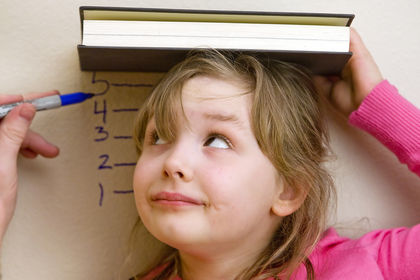Correlation

As used in mathematics, correlation is a measure of how closely two variables change in relationship to each other. For example, consider the variables height and age for boys and girls. In general, one could predict that the older a child is, the taller he or she will be. A baby might be 12 inches long; an 8-year-old, 36 inches; and a 15-year old, 60 inches. This relationship is called a positive correlation because both variables change in the same direction: as age increases, so does height.
A negative correlation is one in which variables change in the opposite direction. An example of a negative correlation might be grades in school and absence from class. The more often a person is absent from class, the poorer his or her grades are likely to be.
The two variables compared to each other in a correlation are called the independent variable and the dependent variable. As the names suggest, an independent variable is one whose change tends to be beyond human control. Time is often used as an independent variable because it goes on whether we like it or not. In the simplest sense, time always increases, it never decreases.
A dependent variable is one that changes as the result of changes in the independent variable. In a study of plant growth, plant height might be a dependent variable. The amount by which a plant grows depends on the amount of time that has passed.
Correlation coefficient
Statisticians have invented mathematical devices for measuring the amount by which two variables are correlated with each other. The correlation coefficient, for example, ranges in value from −1 to +1. A correlation coefficient of +1 means that two variables are perfectly correlated with each other. Each distinct increase or decrease in the independent variable is accompanied by an exactly similar increase or decrease in the dependent variable. A correlation coefficient of +0.75 means that a change in the independent variable will be accompanied by a comparable increase in the dependent variable a majority of the time. A correlation coefficient of 0 means that changes in the independent and dependent variable appear to be random and completely unrelated to each other. And a negative correlation coefficient (such as −0.69) means that two variables respond in opposite directions. When one increases, the other decreases, and vice versa.
Understanding the meaning of correlation
It is easy to misinterpret correlational measures. They tell us nothing at all about cause and effect. For example, suppose that you measured the annual income of people from age 5 to age 25. You would probably find the two variables—income and age—to be positively correlated. The older people become, the more money they are likely to earn.
Words to Know
Correlation coefficient: A numerical index of a relationship between two variables.
Negative correlation: Changes in one variable are reflected by changes in the second variable in the opposite direction.
Positive correlation: Changes in one variable are reflected by similar changes in the second variable.
The wrong way to interpret that correlation is to say that growing older causes people to earn more money. Of course, that isn't true. The correlation can be explained in other ways. Obviously, a 5-year-old child can't earn money the way an 18-year-old or a 25-year-old can. Measures of correlation, such as the correlation coefficient, simply tell whether two variables change in the same way or not without providing any information as to the reason for that relationship.
Of course, scientists often design an experiment so that a measure of correlation will have some meaning. A nutrition experiment might be designed to test the effect of feeding rats a certain kind of food. The experimenter may arrange conditions so that only one factor—the amount of that kind of food—changes in the experiment. Every other condition is left the same throughout the experiment. In such a case, the amount of food is the independent variable and changes in the rat (such as weight changes) are considered the dependent variable. Any correlation between these two variables might then suggest (but would not prove) that the food being tested caused weight changes in the rat.